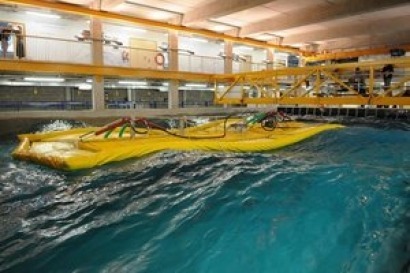
The new wave energy device, the Waveline Magnet wave energy converter (WM7), has been launched by Sea Wave Energy Ltd (SWEL) after eight years research and development with testing in the wave tank at Plymouth University by independent marine energy experts.
The tests followed on from earlier research carried out on the WM6 device in Larnaca Bay, Cyprus, by marine energy researchers from Exeter University in July 2012. The researchers founded that the Waveline Magnet could not only harness wave power in order to generate electricity but could also potentially be used for seawater desalination and preventing coastal erosion through a process of depowering waves.
Furthermore, the device can be manufactured at very low cost per MW in comparison to other wave energy devices. According to its inventor, the Waveline Magnet can generate 1MW of power for less than £1.5 million, as opposed to about £5 million per MW that is typical in marine energy renewables. This means that the device could be economically viable as well as withstanding very challenging adverse marine conditions reliably for many years.
“As the sea is a very hostile environment, most marine energy developers design heavy displacement devices in order to withstand the stormy conditions.” said Waveline Magnet inventor Adamos Zakheos. “We have done exactly the opposite. Our Waveline Magnet device is buoyancy-neutral and adheres to the surface of the water, so it follows precisely the contour of the wave as the wave passes ‘through’ the device. In this way, the Waveline Magnet presents minimum resistance to the force of the wave - whatever its size - and this not only enhances its ability to capture the power within the wave but also massively increases the survivability of the device.”
The team at SWEL believes that the design of the Waveline Magnet offers the optimum solution in capturing as much of the available energy from waves at the lowest possible cost. In tests carried out over two days on 5th and 6th March this year, the WM7 delivered in excess of 1.3kW on a wave set duration of 2.5 seconds at a wave height of just 60cm (24”). From the test data, Mr Zakheos has calculated that an array of ten full-sized devices, each one measuring 200 metres in length and 50 metres wide, will deliver in excess of 15MW – enough energy to power at least 13,000 homes.
SWEL is now planning to construct a new device, measuring 100m by 50m, called the WM8 which will be deployed at FaB Test in Falmouth Bay for further testing in the sea over a minimum period of six months in order to assess its durability and power output in a range of sea conditions. The next stage, the development of the WM9, will involve a full size device for deployment at Wavehub, the world’s largest grid-connected facility, at Hayle in Cornwall. This will enable the electricity generated by the device to be brought ashore by a grid-connected undersea cable connector. SWEL is now seeking additional investment in order to complete the development process and drive the technology forward.
Further information:

